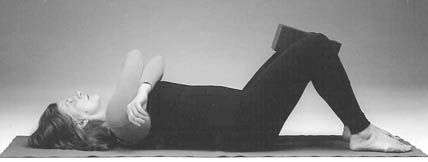|
|
|
A Key to Health Getting to Know Your Psoas
by Liz Koch • Felton, CA
The day my
mom went into the hospital for her hip replacement, the doctor had already
performed eight others. Back and knee problems seem as common as the common
cold. So what gives? Is it true that the body wears out like an old car
part– or is our mindset a common but limited perspective on the healing
capabilities of the human body?
It was around the beginning of the industrial revolution that the idea
that human beings were like machines came into being. The body was seen
as being like a clockwork toy, capable of being taken apart, parts replaced
and then put back together again. Although this perspective has produced
powerful life saving procedures, this view also limits our awareness of
the wonders of the human body and life itself.
Coming to understand the human body as a living system shifts our paradigm
of health. The same self-healing possibilities that repair a cut or heal
a bruise are always working to self-correct every system within a human
being. Understanding that problems come about when we somehow interfere
with the capability of our bodies to self-correct shifts our perspective
from fixing the problem to the ancient concept of prevention. Going from
the goal of curtailing discomfort, pain and illness to supporting the
body’s self-correcting power awakens us to the possibility of inhabiting
a joyful body. We can take steps to stop interfering with the body’s
natural processes.
A vital key to prevention and self-corrective possibilities rests with
one muscle, the psoas (so-as.) Getting to know this muscle can have far
reaching results in reducing wear and tear on the hip joints, knees and
spine. A supple, dynamic psoas reduces stress, enhances digestion and
eliminates fatigue. Here are a few facts about the psoas that might encourage
you to develop a better relationship with yours.
The psoas is the core muscle of the body, maintaining fluid motion while
walking. It attaches along the front of the spine. It is the only muscle
attaching the spine to the leg, as it spans from solar plexus to upper
thigh. All problems associated with the lower back, hip sockets, knees
and ankles can be greatly improved by releasing tension in the psoas and
engaging it properly while sitting and walking.
However, the psoas is more than a muscle. It is also a shelf, providing
support for all the abdominal organs. In addition, it is a hydraulic pump
that, in combination with the diaphragm, massages the internal organs,
viscera and spinal fluid. It is also part of the fear reflex (the fight
or flight response,) and has a great deal to do with your gut feelings,
or what you know to be true for you.
Like the info-mercial products that clean everything from car parts to
fine china, and can be served as a topping on desserts, learning about
your psoas muscle is likely to help just about everything.
Gaining a supple psoas relieves a wide range of symptoms; everything from
menstrual cramps, water retention, sleep difficulties and foot rotations
to recovering from deep-seated fears and trauma.
A simple technique for releasing your psoas is the constructive rest position:

Rest on your back with knees bent and your feet placed parallel to each
other, the same distance apart as the front of your hip sockets. Place
your heels approximately 16-24 inches away from your buttocks. Keep your
trunk and head parallel with the floor. DO NOT push or flatten the spine
or tuck your pelvis. Simply rest in this position for 10-20 minutes. In
this position, gravity releases the psoas.
To keep your hip sockets open and your pelvis balanced while sitting,
here is another exercise: Use a flat seated chair and sit with your pelvis
level and your weight in front of your tuberosities (sits bones.) Keep
your hips parallel with the floor and the knees lower than your hip sockets.
This keeps the psoas released while it increases blood circulation throughout
the hip sockets, legs and feet.
Getting to know your psoas and learning ways to free its movement will
keep your inherent self-corrective system vital. This leads to ease of
movement and self-expression. Tuning into your psoas can help you face
life with a smile.
Liz Koch is the author of The Psoas Book, a comprehensive
guide to the Iliopsoas Muscle and its profound effect on the body/mind/emotions.
She will be teaching a weekend workshop March 29-30th at The Yoga Room
in East Patchoque. For more info, visit her website: www.coreawareness.com
|

